Terramaster D1 SSD Review – Performance Made Sustainable?
The TerraMaster D1 SSD Plus is a compact, single-bay M.2 NVMe enclosure designed to deliver high-speed direct-attached storage over USB4, with a focus on professional workloads that demand both speed and stability. Aimed at users working with large, high-resolution files such as 4K and higher video editing projects, RAW photo archives, and heavy multimedia workflows, it supports transfer rates of up to 3,853MB/s read and 3,707MB/s write when paired with a compatible PCIe Gen 4×4 SSD. This performance level allows a 3GB file to transfer in around one second under optimal conditions, significantly reducing waiting times in post-production processes. The enclosure is compatible with a broad range of connection standards, including Thunderbolt 5/4/3 and USB4/3.2/3.1/3.0, making it adaptable to both modern and legacy system configurations. Measuring 112.5 × 60 × 33 mm and weighing 246g, it features a fully enclosed aluminium alloy body with passive cooling, designed to keep temperatures stable during sustained workloads without introducing fan noise. Additional onboard safeguards provide short-circuit, voltage surge, and electrostatic discharge protection, while its unibody construction aims to withstand continuous use in demanding environments. With no pre-installed SSD, the D1 SSD Plus supports M.2 2280 NVMe drives up to 8TB, giving users the flexibility to choose their own storage based on performance or capacity priorities.
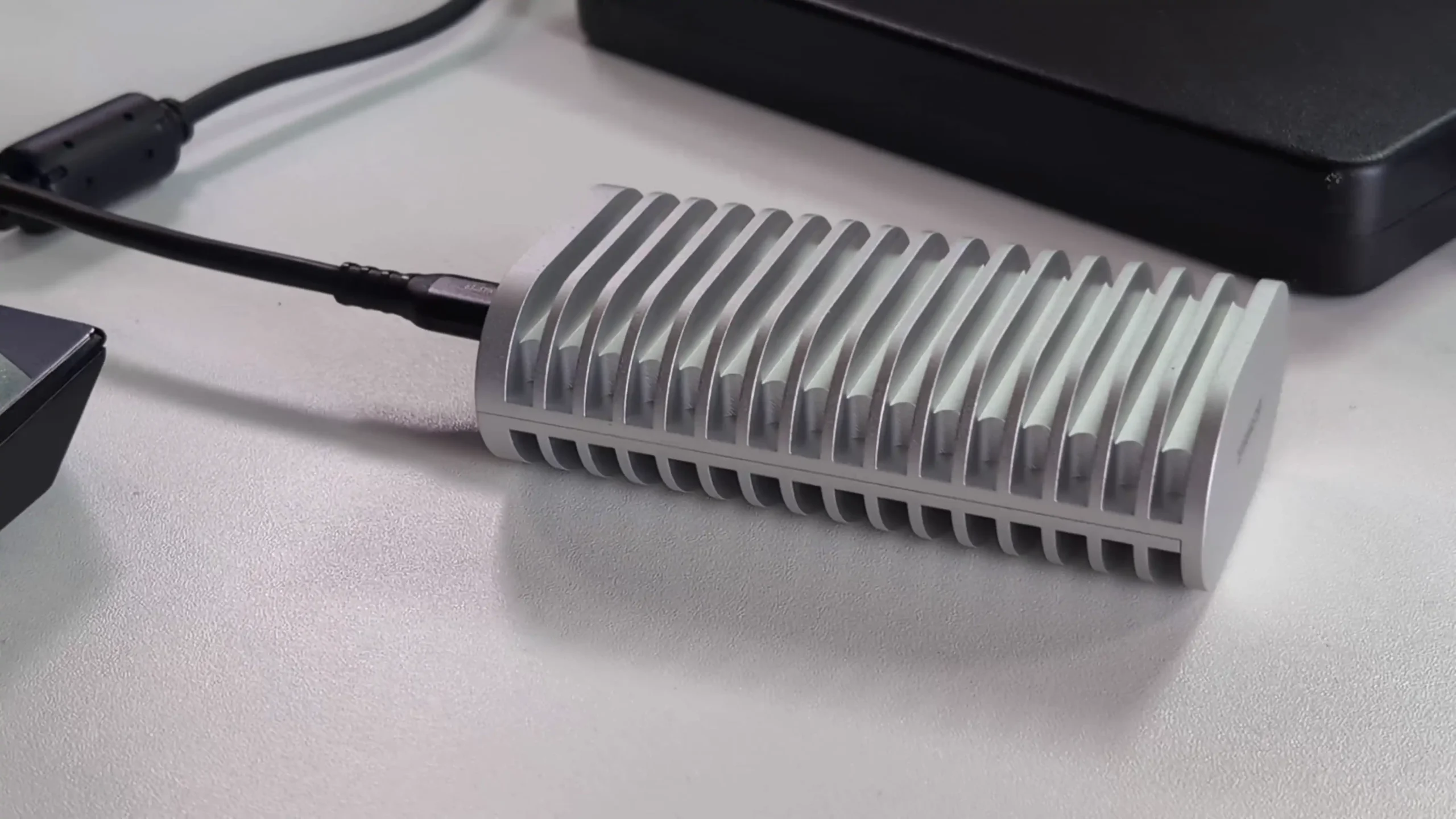
Terramaster D1 SSD Review – Quick Conclusion
The TerraMaster D1 SSD Plus is a compact, bus-powered USB4 enclosure built for sustained high-speed storage with a focus on stability, thermal efficiency, and cross-platform compatibility. Using the ASMedia ASM2464PDX controller with a PCIe Gen 4×4 lane configuration, it can fully exploit 40Gbps bandwidth when paired with a suitable SSD, maintaining 3,000MB/s+ read and 2,500MB/s+ write speeds without throttling during prolonged workloads. Its fully aluminium passive cooling design keeps drive temperatures around 44–45°C under heavy use while remaining completely silent, making it suitable for both desktop and field use. Supporting capacities up to 8TB, multiple file systems, and connection standards including Thunderbolt 5/4/3 and USB 3.x, it integrates easily into macOS and Windows workflows. However, the short 0.3m USB4 cable can limit positioning flexibility, and performance is heavily dependent on choosing a PCIe Gen 4×4 SSD, with no official compatibility list provided. Overall, it offers strong build quality, sustained performance, and portability, making it a capable option for professionals and power users seeking reliable high-speed external NVMe storage.
Where to Buy a Product





![]()
![]()

VISIT RETAILER ➤






![]()
![]()

VISIT RETAILER ➤






![]()
![]()

VISIT RETAILER ➤






![]()
![]()

VISIT RETAILER ➤
|
Terramaster D1 SSD NAS |
|
|
Amazon in Your Region for the Terramaster D1 SSD @ $109 |
B&H for the Terramaster D1 SSD USB4 Drive @ $109.99 |
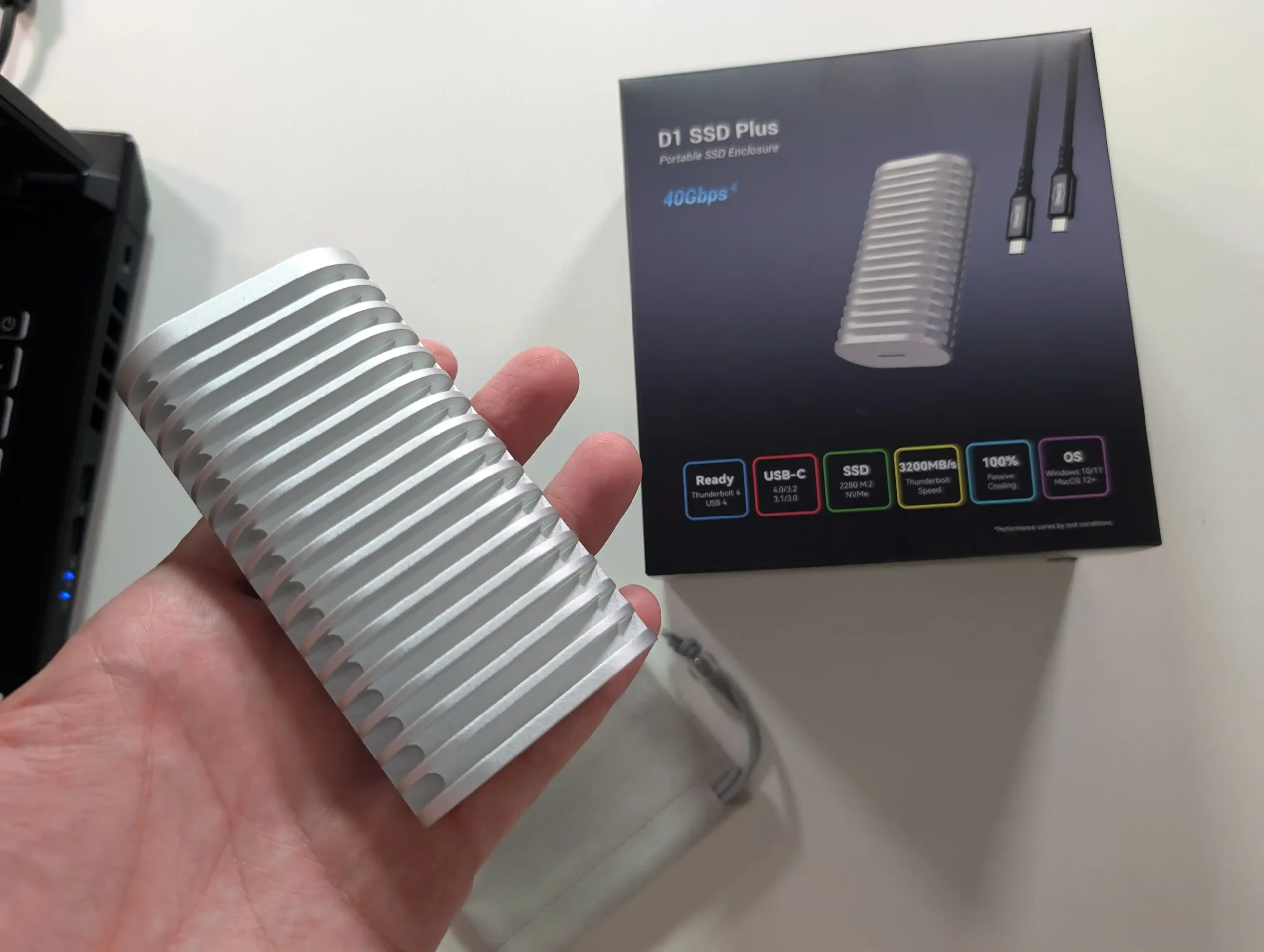
Terramaster D1 SSD Review – Design and Storage
The D1 SSD Plus adopts a minimalist, industrial-style design built entirely from aluminium alloy, providing both structural durability and efficient passive heat dissipation. Its solid unibody construction not only makes the device more resistant to daily wear but also allows for a larger heat-spreading surface compared to typical plastic or hybrid enclosures. Measuring just over 11 cm in length, it remains small enough for mobile use while retaining the thermal mass needed to handle sustained high-speed transfers without performance throttling. The matte finish helps reduce the appearance of fingerprints and scratches, making it better suited to frequent handling in professional environments.
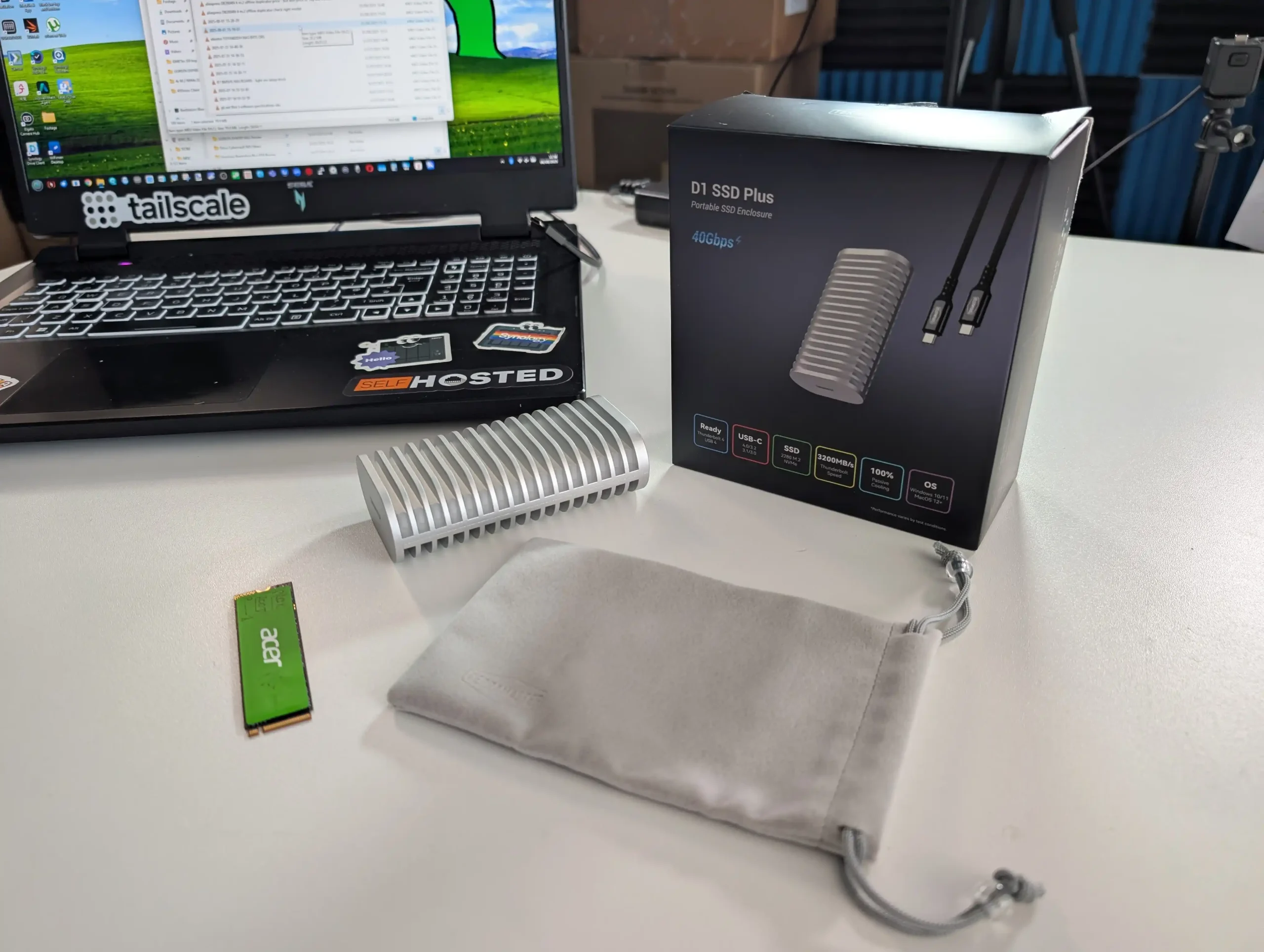
Internally, the unit supports a single M.2 2280 PCIe NVMe SSD, accommodating capacities of up to 8TB in a single slot. The choice to limit support to NVMe, rather than SATA-based M.2 drives, ensures the interface is not a bottleneck to the USB4 connection. The enclosure uses a PCIe Gen 4×4 lane allocation, meaning that while it can achieve impressive transfer speeds, installing a Gen 3 drive will limit throughput to roughly half the rated maximum. This makes SSD selection critical for users seeking top performance, especially in workflows involving large sequential file transfers or high-speed scratch disk usage.
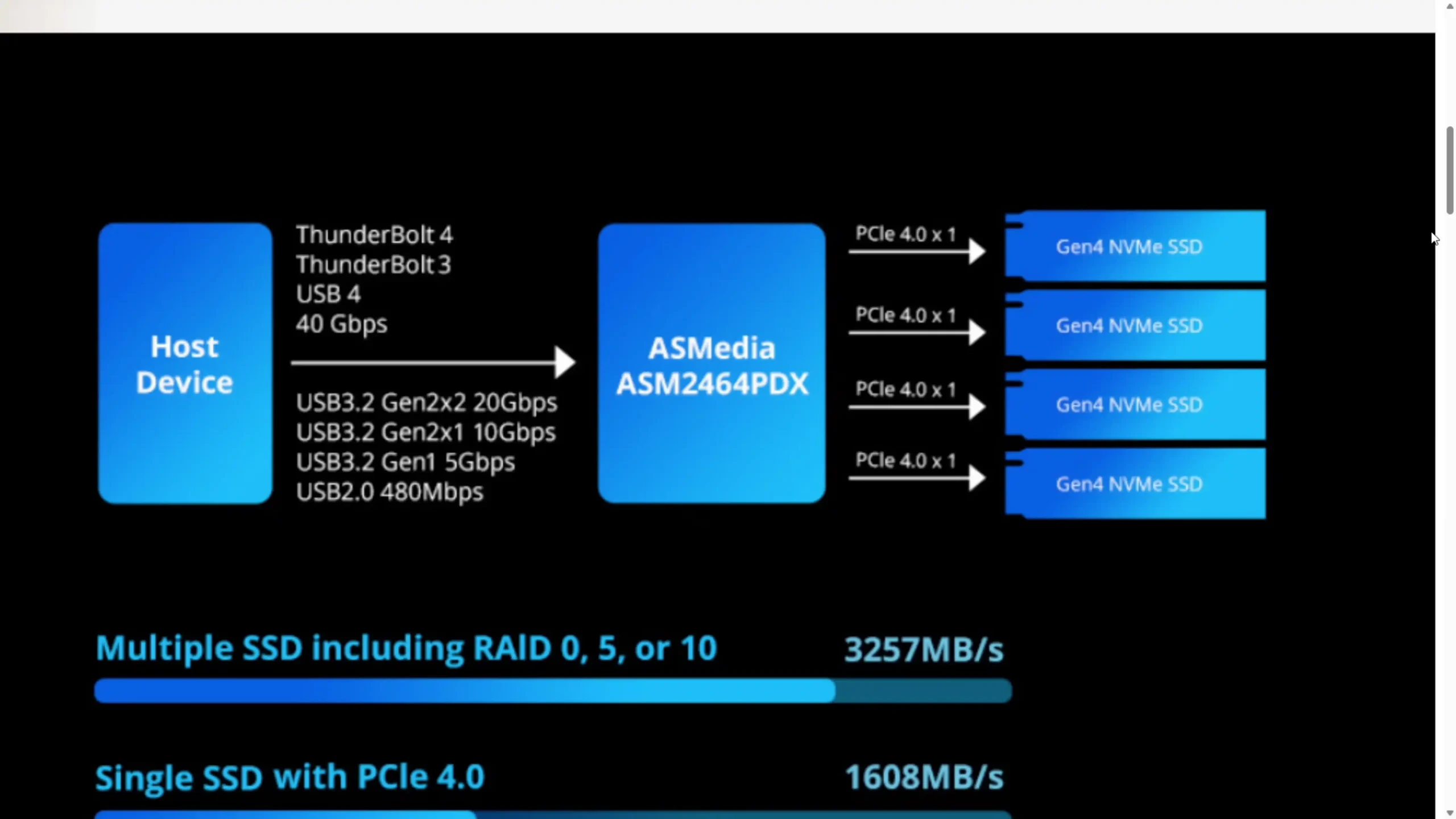
The passive cooling system is one of the more notable aspects of the D1 SSD Plus’s design. Instead of an active fan, the aluminium chassis itself acts as a heatsink, with thermal pads positioned to draw heat away from the SSD and controller. During testing with repeated large file transfers, drive temperatures peaked at around 44–45°C, and the enclosure exterior measured approximately 41–42°C, remaining well below thermal throttling thresholds. This approach eliminates moving parts, improving reliability and making the device completely silent, a benefit for audio-sensitive production environments.
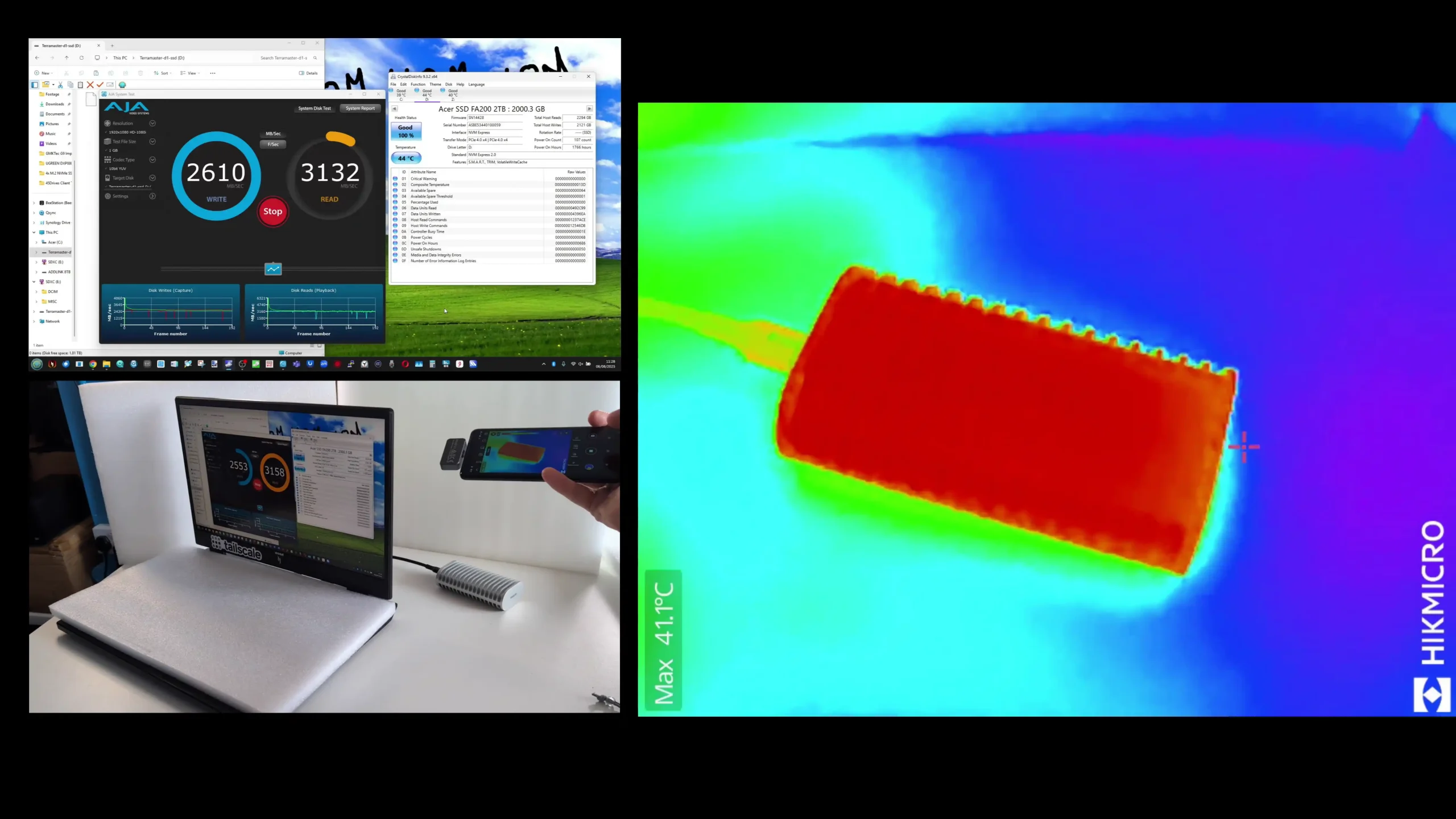
From a portability perspective, the D1 SSD Plus is supplied with a compact 0.3m USB4 Type-C cable and a soft carry bag for transport. The short cable supports 40Gbps data rates and up to 240W power delivery, though its length may be restrictive for certain setups, such as when connecting to desktop systems positioned under a desk. Weighing just 246grams without a drive, it is light enough to be carried daily yet solid enough to feel substantial in use.
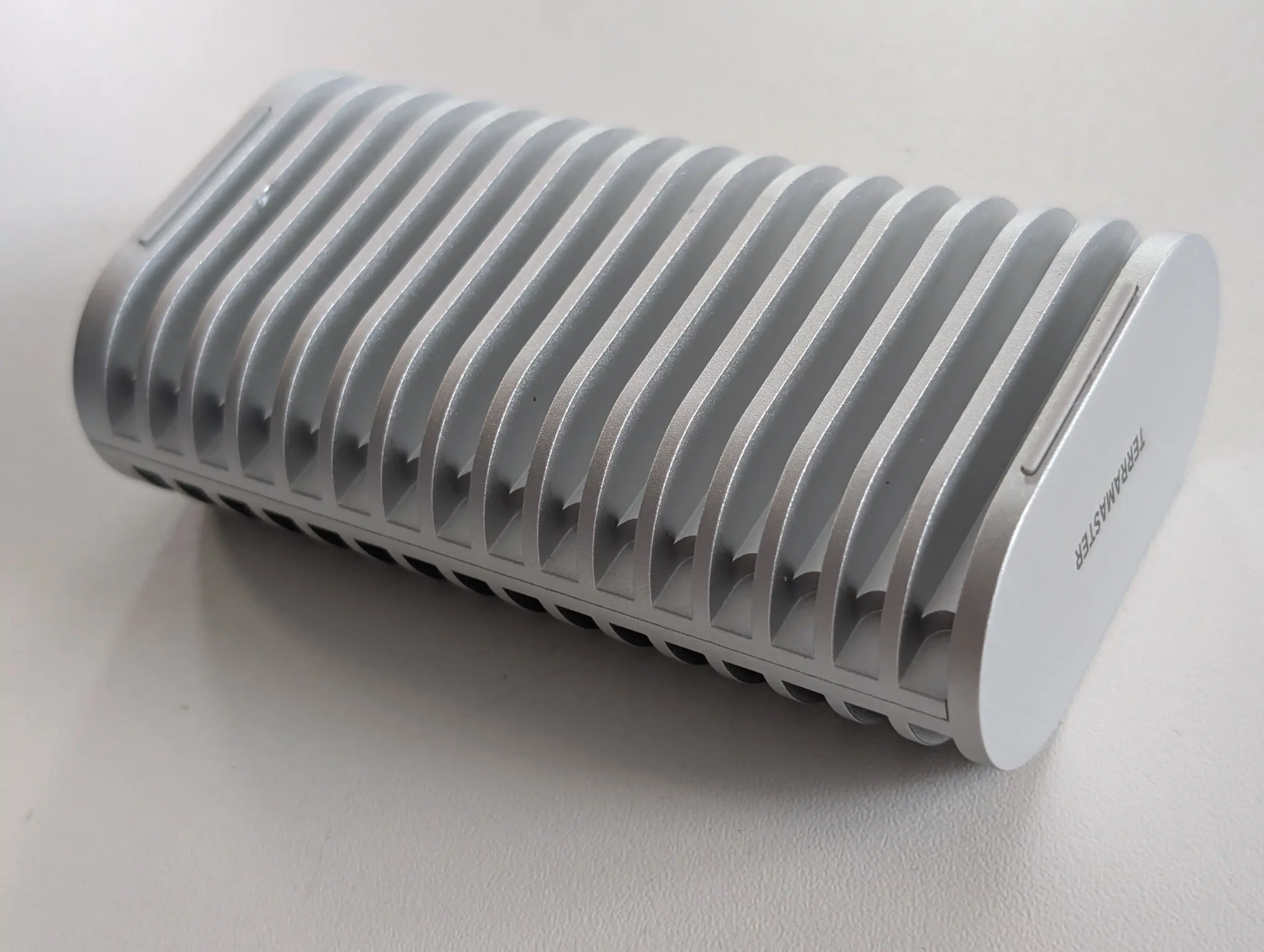
In terms of safety and operational protection, TerraMaster has included components to guard against short circuits, power surges, and electrostatic discharge. These measures, combined with the robust chassis, aim to keep the enclosure operational even in less controlled environments such as on-location shoots or travel-based editing sessions. For storage expansion scenarios, it can act as either a primary drive for active projects or a fast external repository for completed work, depending on the installed SSD’s performance and endurance characteristics.
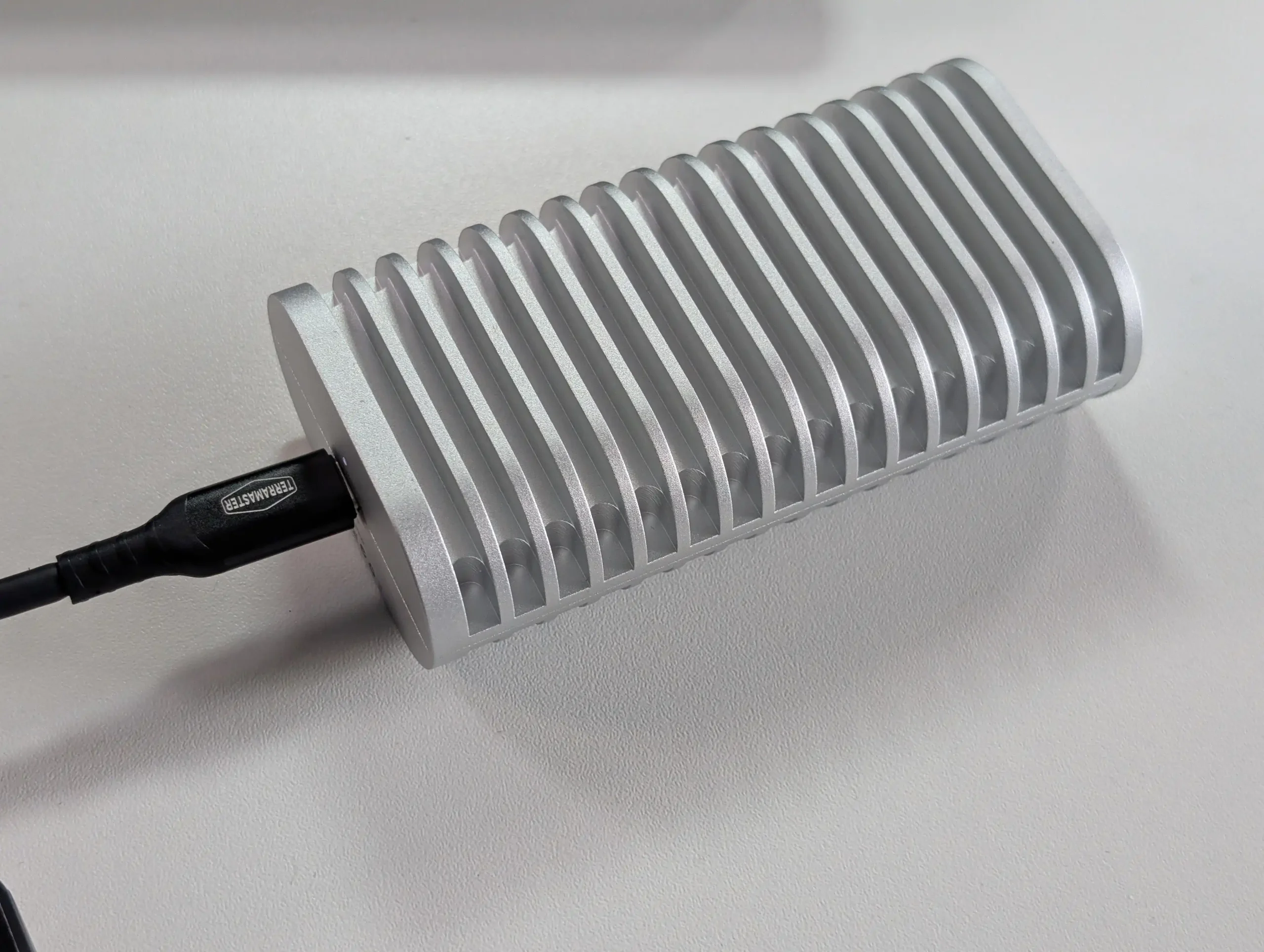
Terramaster D1 SSD Review – Internal Design
Inside the D1 SSD Plus, the primary component enabling its performance is the ASMedia ASM2464PDX controller. This USB4-to-PCIe bridge is widely used in high-speed external enclosures, offering stable throughput and supporting PCIe Gen 4×4 lane allocation to the installed SSD. TerraMaster is unusually transparent in publicly listing the controller model and lane configuration, information that many manufacturers omit. This clarity helps users understand the real-world performance limits and the importance of pairing the enclosure with a compatible SSD to reach the quoted speeds.
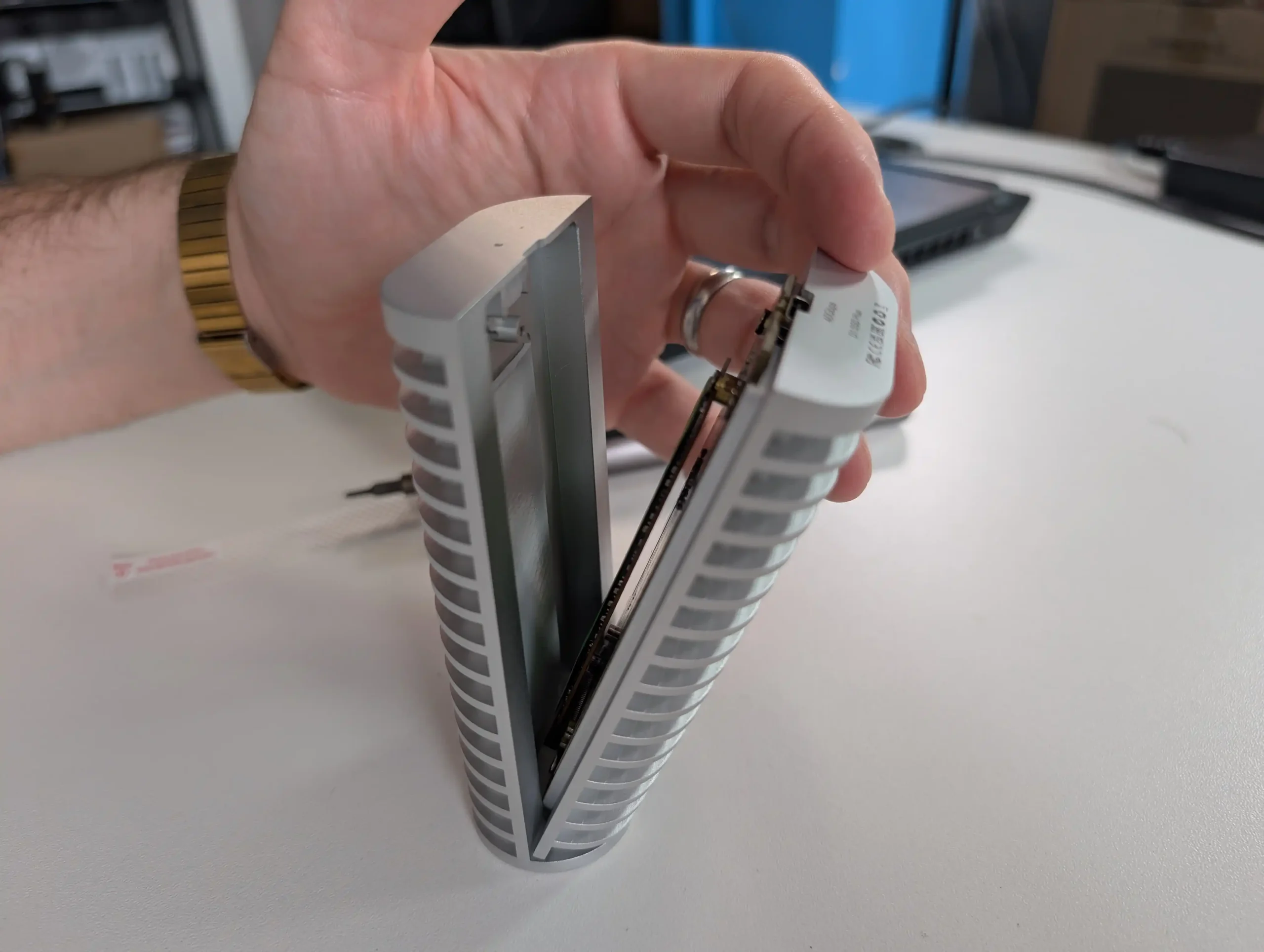
The M.2 slot supports the 2280 form factor exclusively and is physically keyed for NVMe drives, preventing the installation of incompatible SATA models. Internally, thermal pads are pre-positioned to ensure consistent contact between the SSD and the aluminium housing, which doubles as a heatsink. This direct contact method maximises heat transfer efficiency, enabling the enclosure to sustain high-speed operation without thermal throttling. The lack of an active fan reduces power draw and potential mechanical failure points, aligning the product with professional needs for quiet and reliable operation.
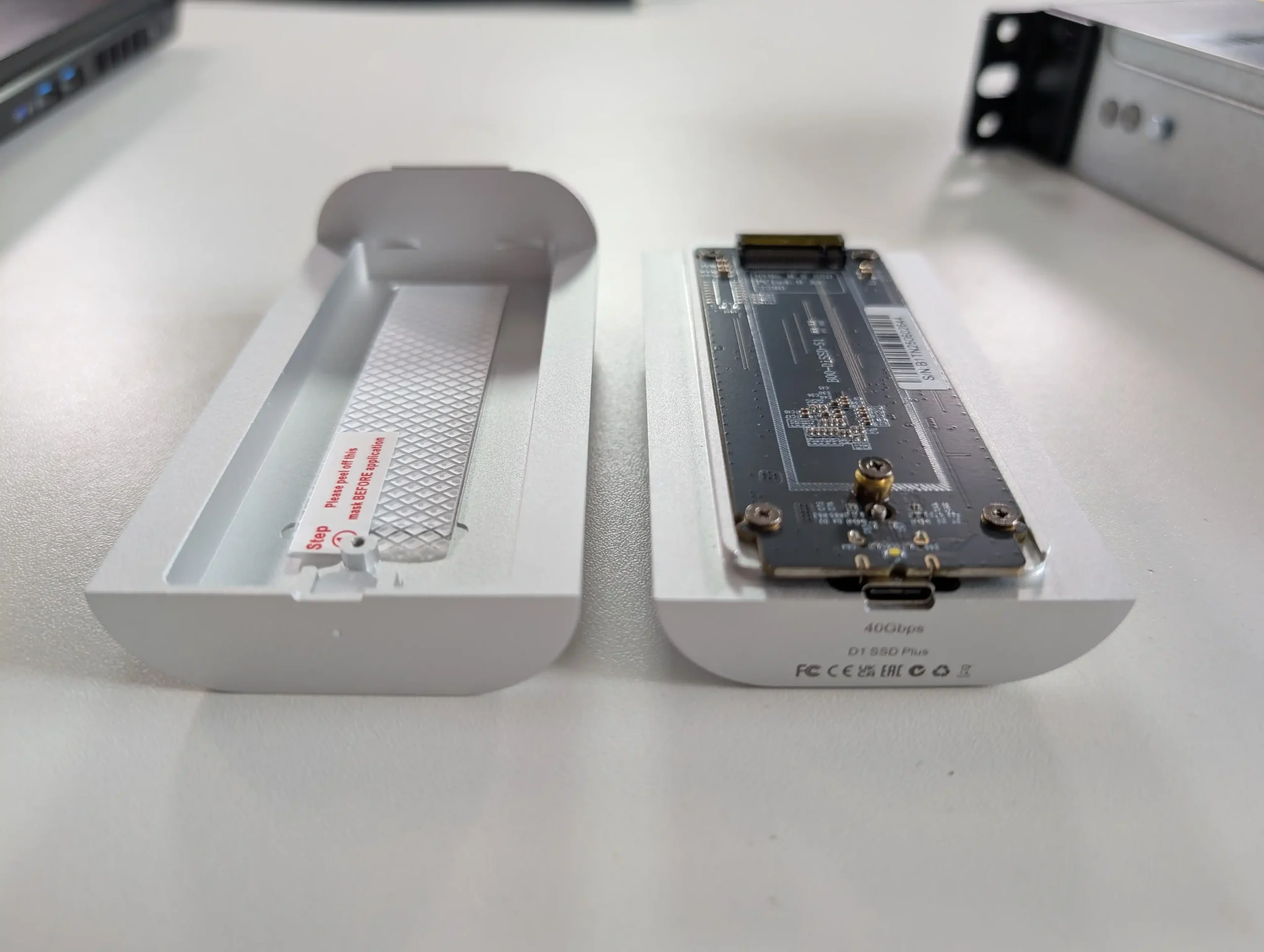
The enclosure draws power entirely from its USB4 connection, operating at 5V and consuming up to 7.5W during active read/write workloads. In idle or hibernation mode, this drops to around 5.5W. The absence of a dedicated power supply simplifies setup and enhances portability, though it also means that connection stability is dependent on the host device’s USB port quality and adherence to USB4 or Thunderbolt specifications. This bus-powered approach makes the D1 SSD Plus practical for mobile workstations, ultrabooks, and modern desktops without spare power connections.
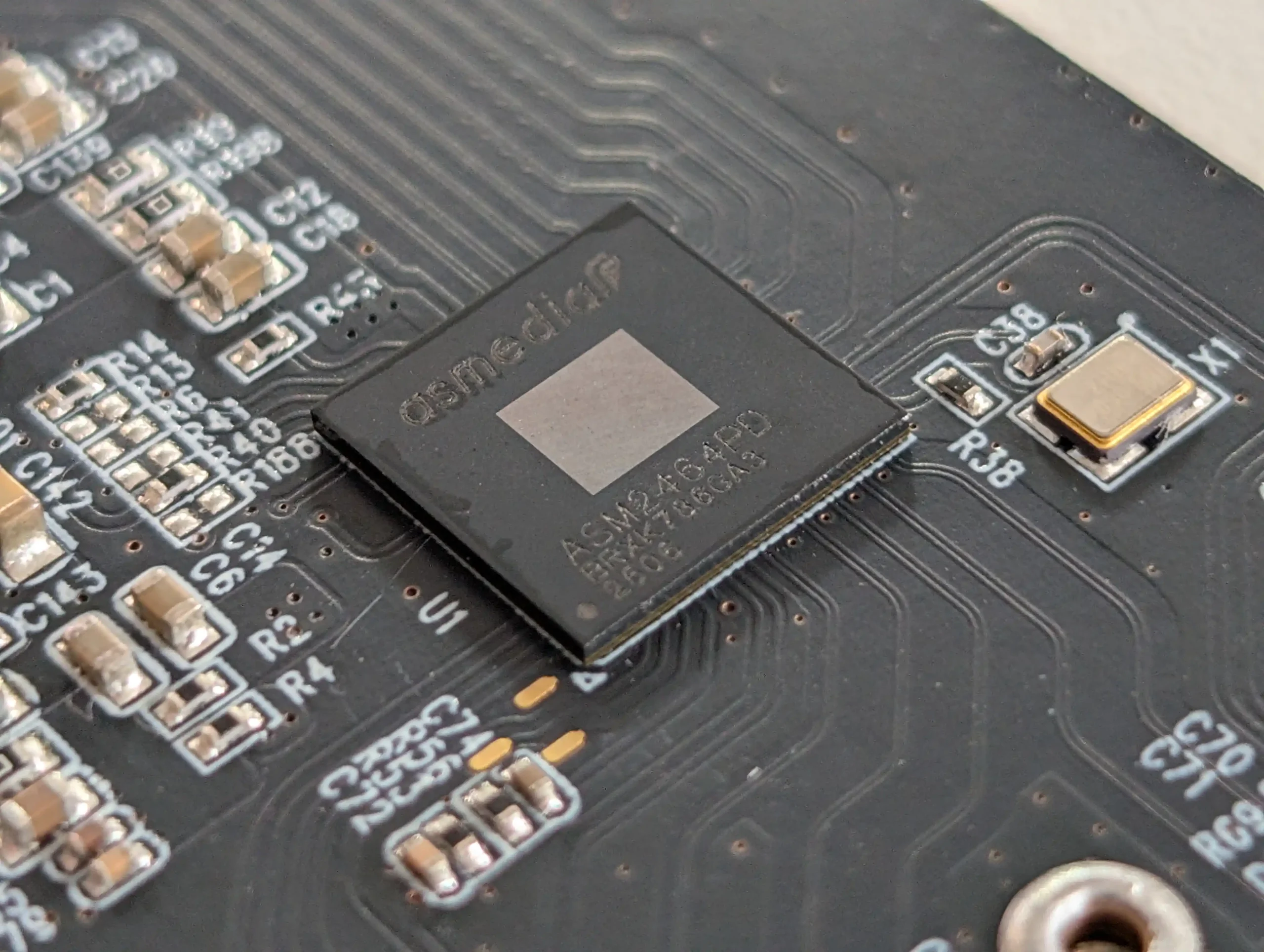
| Component / Feature | Detail |
|---|---|
| Controller | ASMedia ASM2464PDX (USB4 to PCIe Gen 4×4 bridge) |
| Supported SSD Types | PCIe NVMe M.2 2280 only |
| Maximum Supported Capacity | 8TB (single drive) |
| Lane Allocation | PCIe Gen 4×4 |
| Cooling System | Passive aluminium heatsink with thermal pad contact |
| Power Source | Bus-powered via USB4 (5V) |
| Power Consumption | 7.5W active, 5.5W hibernation |
| Thermal Management | Peak SSD temp ~45°C, enclosure ~42°C under sustained load |
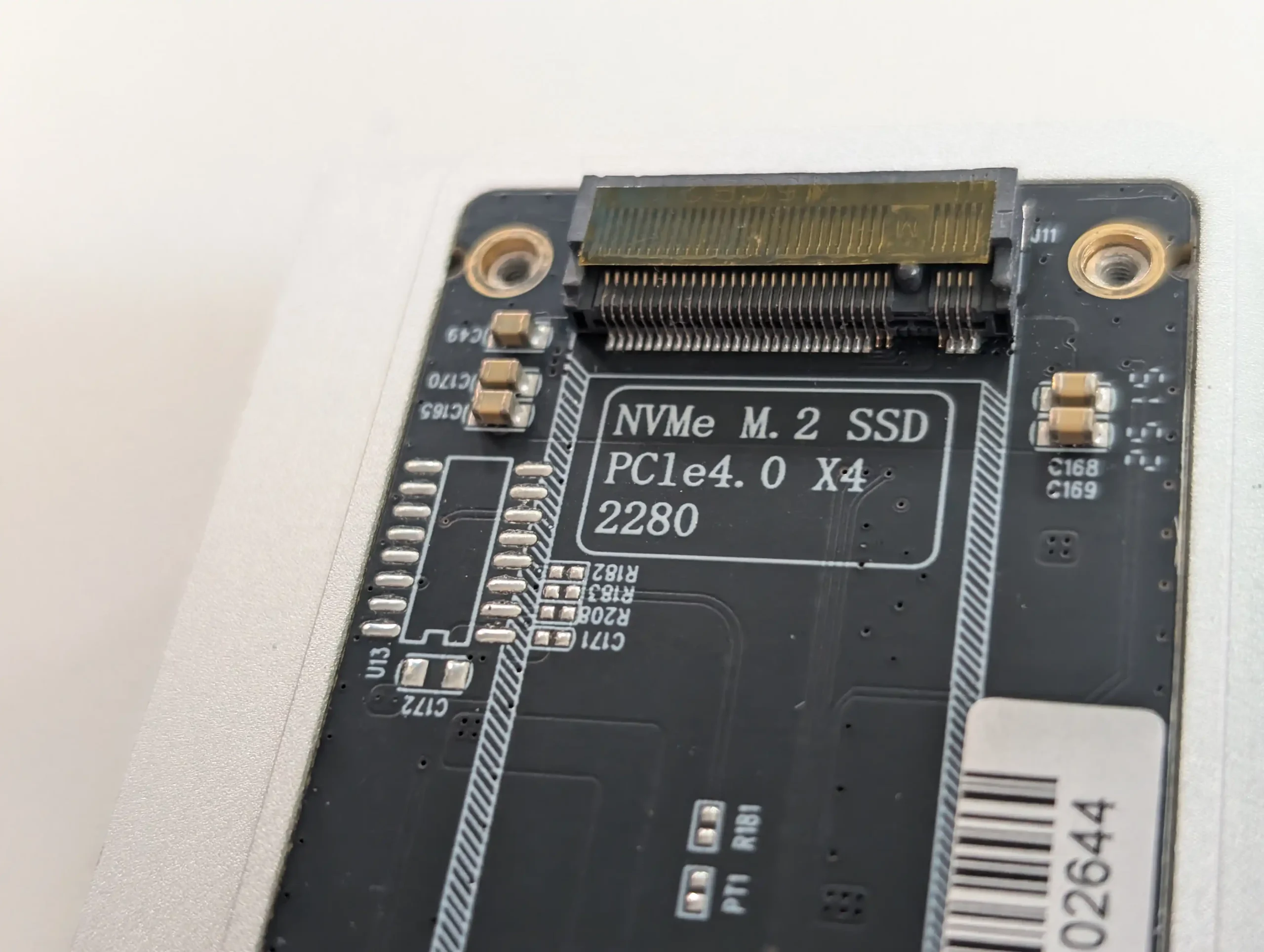
Terramaster D1 SSD Review – Connection and Bandwidth
The D1 SSD Plus features a single USB Type-C port located at the rear of the enclosure, serving as its sole data and power interface. This port supports USB4 at 40Gbps, ensuring maximum compatibility with modern high-speed standards while maintaining backward support for Thunderbolt 5/4/3 and USB 3.x generations. This allows the enclosure to integrate into a range of environments, from the latest Apple Silicon systems to older Windows workstations. However, TerraMaster notes that certain Thunderbolt 3-equipped Windows PCs may lack complete USB4 protocol support, which can prevent the device from being recognised unless connected to a different port.
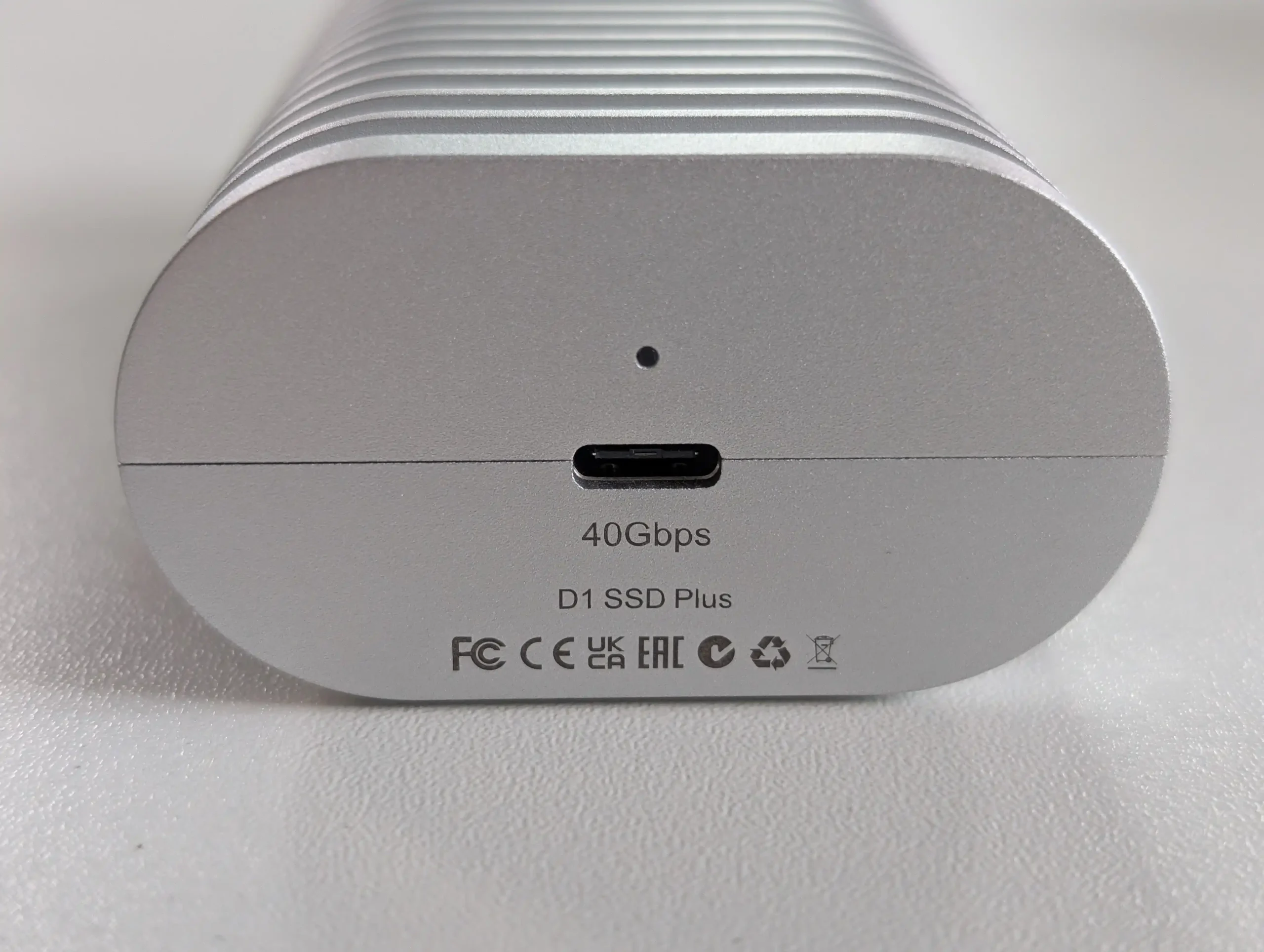
The included 0.3m USB4 cable is rated for the full 40Gbps bandwidth and supports up to 240W of power delivery, even though the enclosure itself draws only a fraction of that power. Its short length makes it well-suited for portable laptop-based workflows but less ideal for desktop systems that require longer reach. Users seeking more flexibility may need to source a third-party cable with equivalent specifications to maintain the enclosure’s full performance potential.
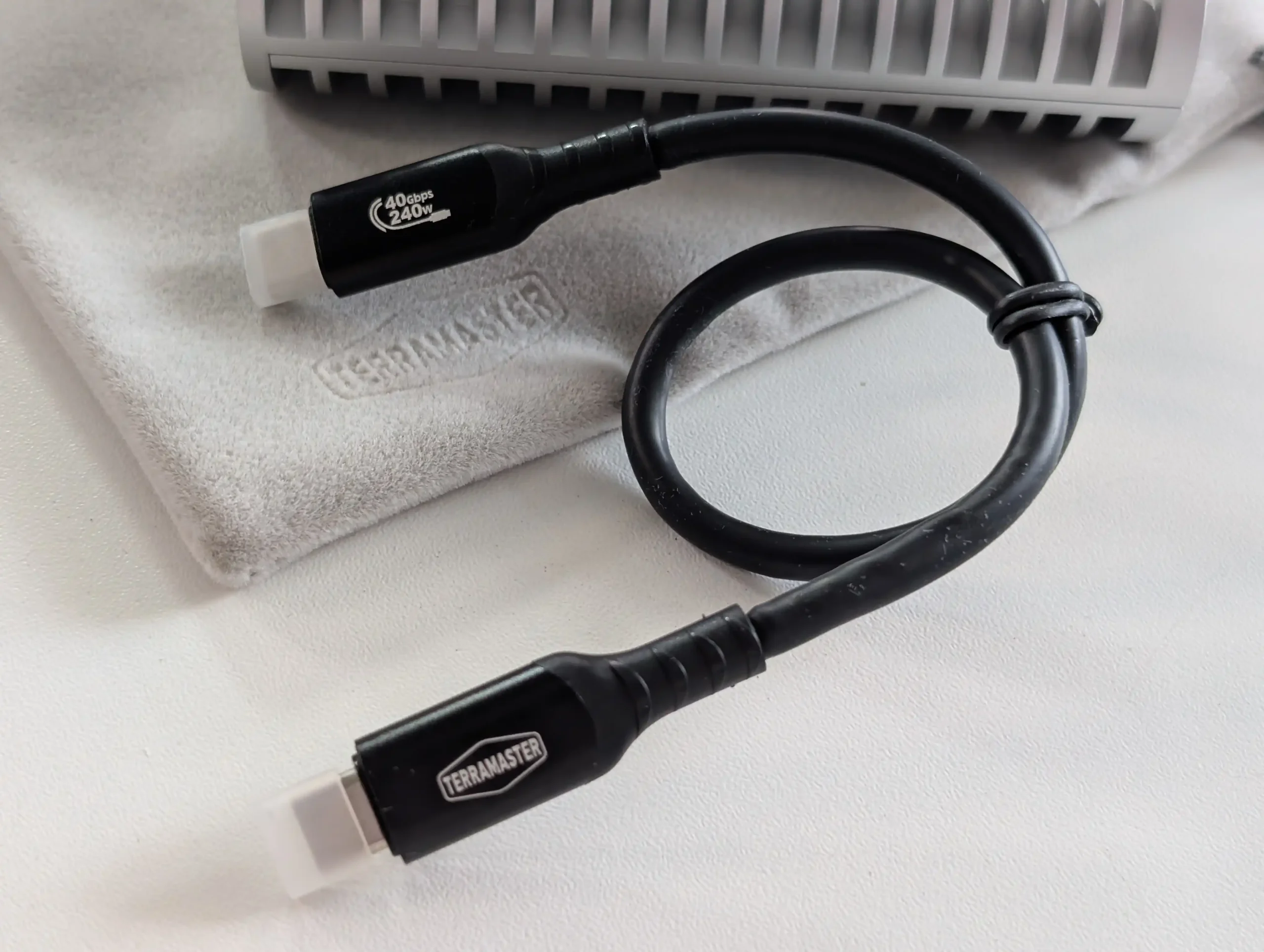
Given the high-speed nature of USB4, signal integrity is critical. The D1 SSD Plus uses a reinforced internal connector to reduce wear and maintain a stable connection over repeated cable insertions. Combined with the aluminium body’s shielding properties, this helps minimise data errors and interference, which is particularly relevant when transferring large multimedia files or working directly from the drive in editing software.
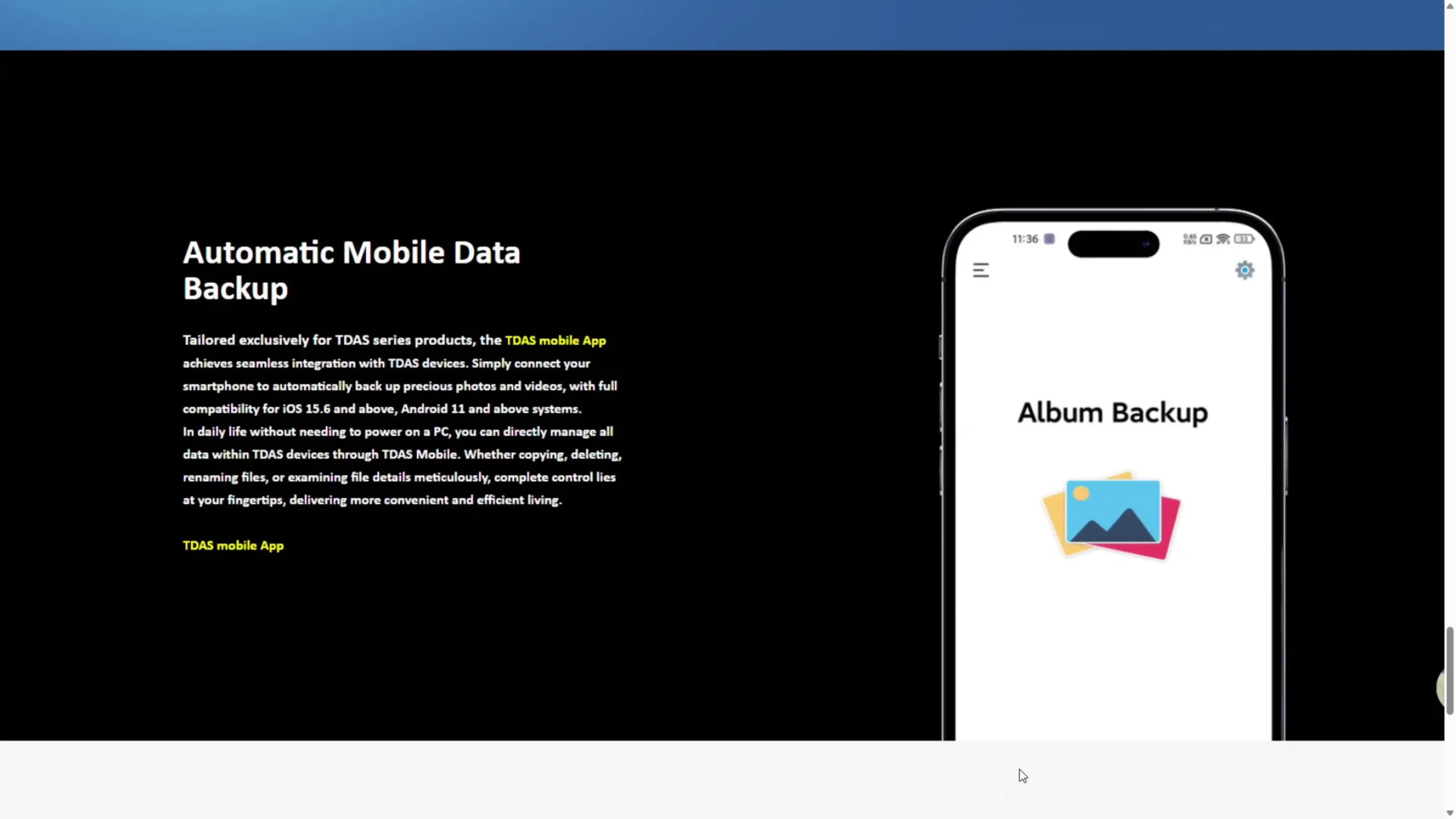 |
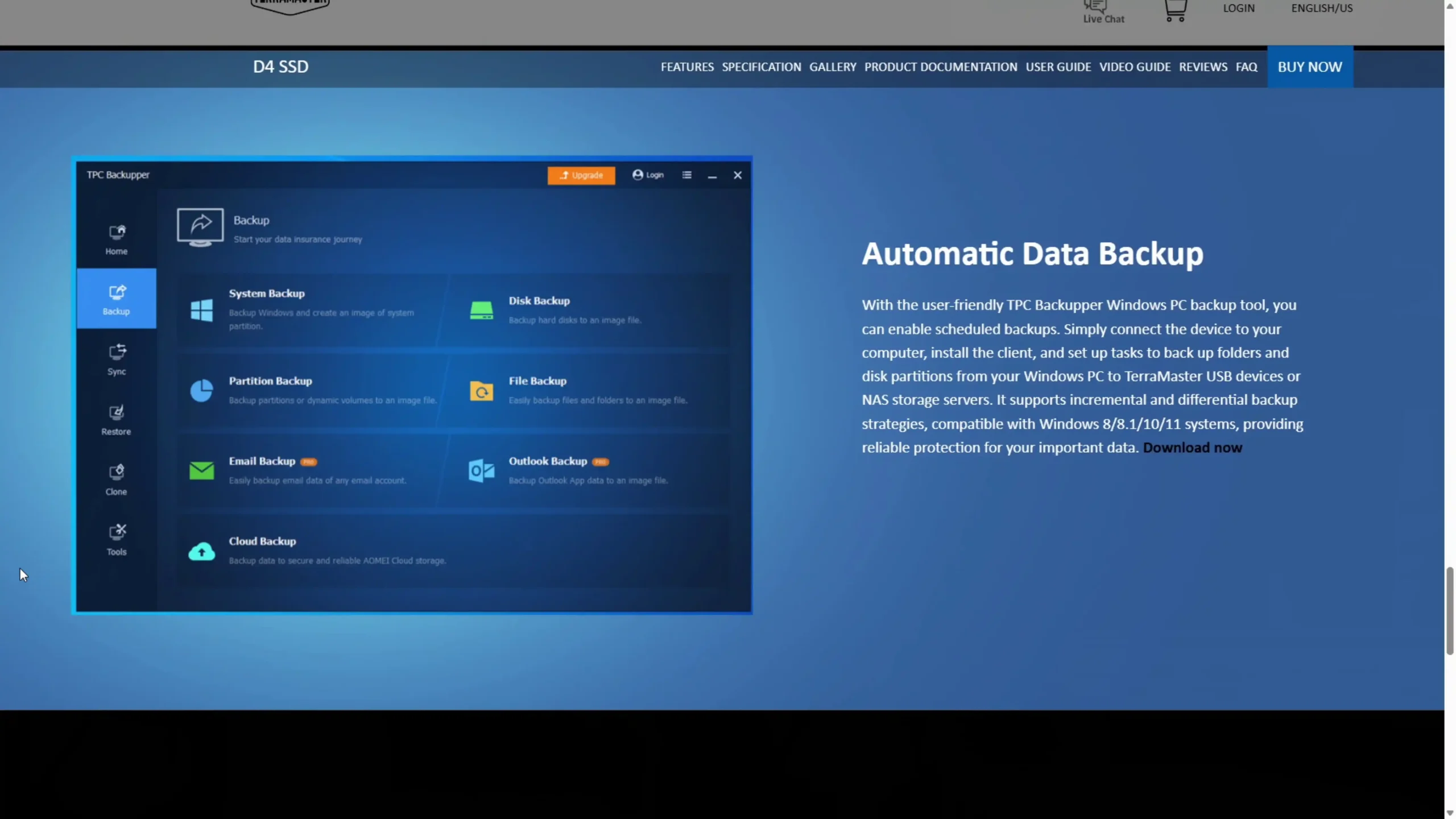 |
Terramaster D1 SSD Review – Tests
In synthetic benchmarks, the D1 SSD Plus achieved results close to its advertised maximums when paired with a high-quality PCIe Gen 4×4 SSD. Using an AJA 1GB test file loop, sustained read speeds were observed between 3,000 and 3,100MB/s, with writes maintaining 2,550 to 2,600MB/s.
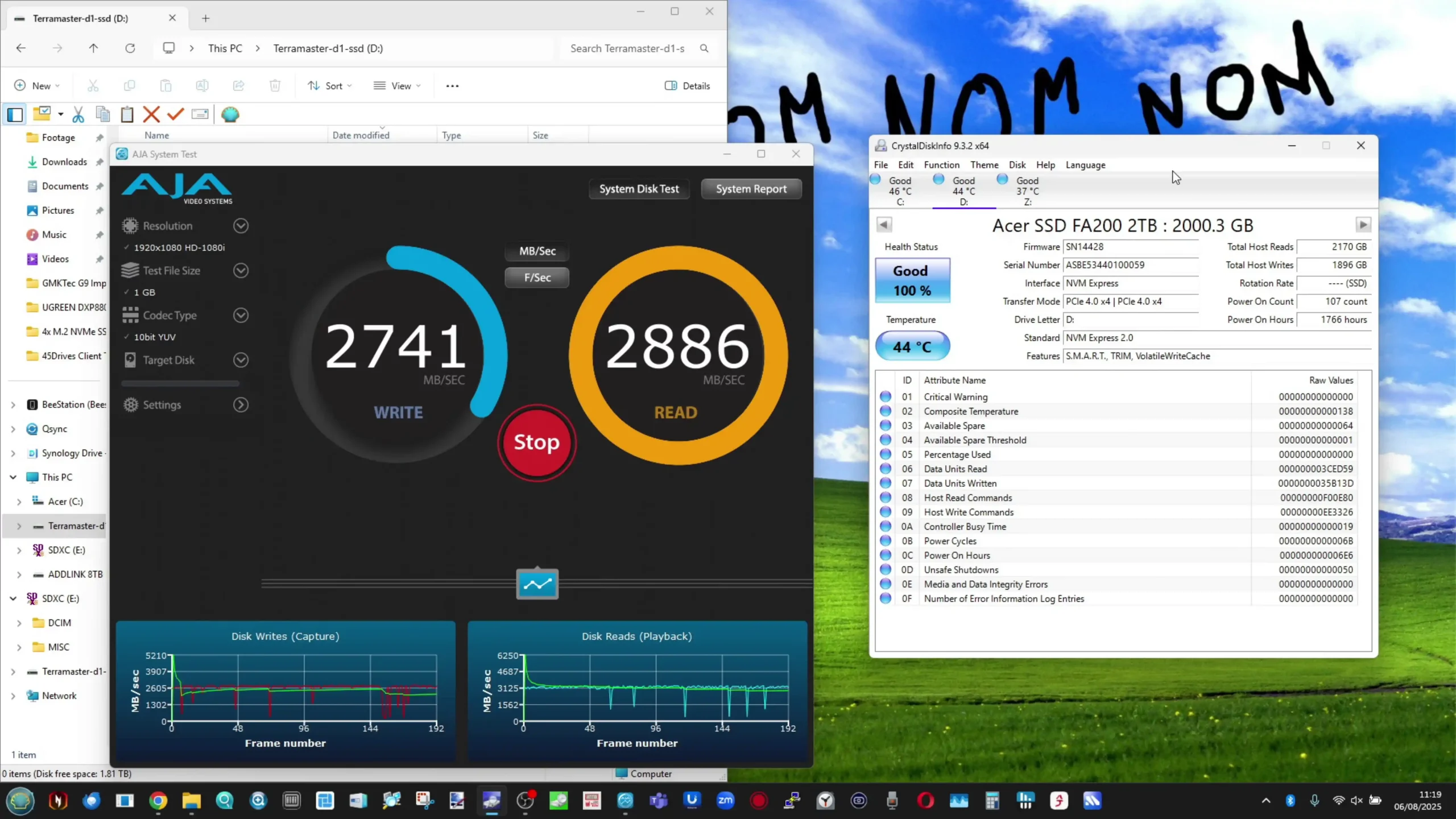
Peak measurements during testing reached 3.55GB/s for reads and 2.8GB/s for writes, confirming that the enclosure can deliver high throughput consistently without early throttling. Mixed workload tests, such as a 70/30 read/write access pattern, still sustained around 2,500MB/s, indicating balanced performance even under varied data operations.
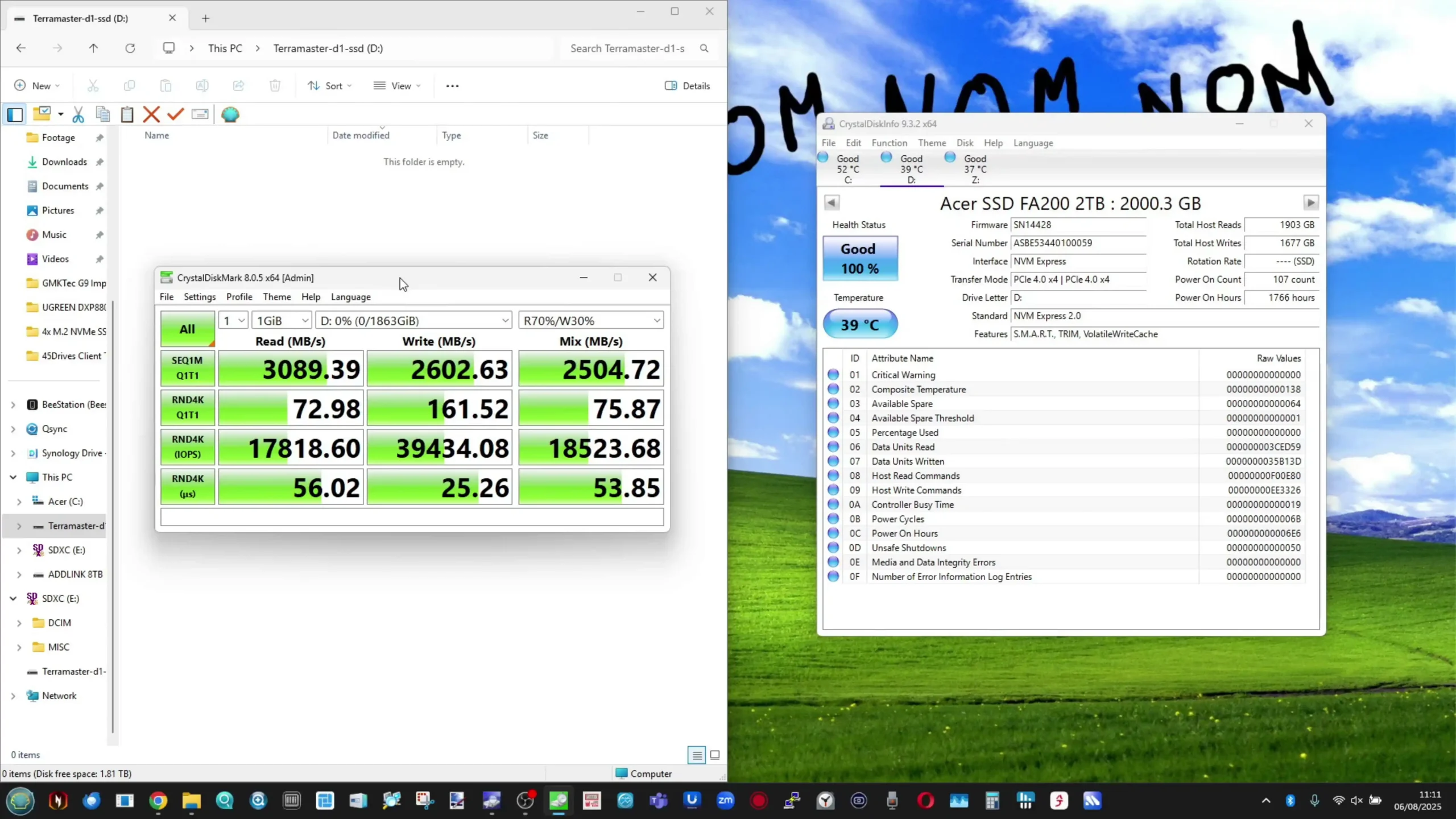
CrystalDiskMark results mirrored the AJA findings, with sequential read speeds consistently exceeding 3,000MB/s and writes holding near 2,600MB/s in repeated trials. These figures place the D1 SSD Plus among the faster single-bay USB4 enclosures currently available, particularly in its ability to sustain speeds over prolonged activity. The stability here is largely attributed to the passive aluminium cooling, which prevented temperature-induced drops in transfer rates that are common in less thermally capable designs.
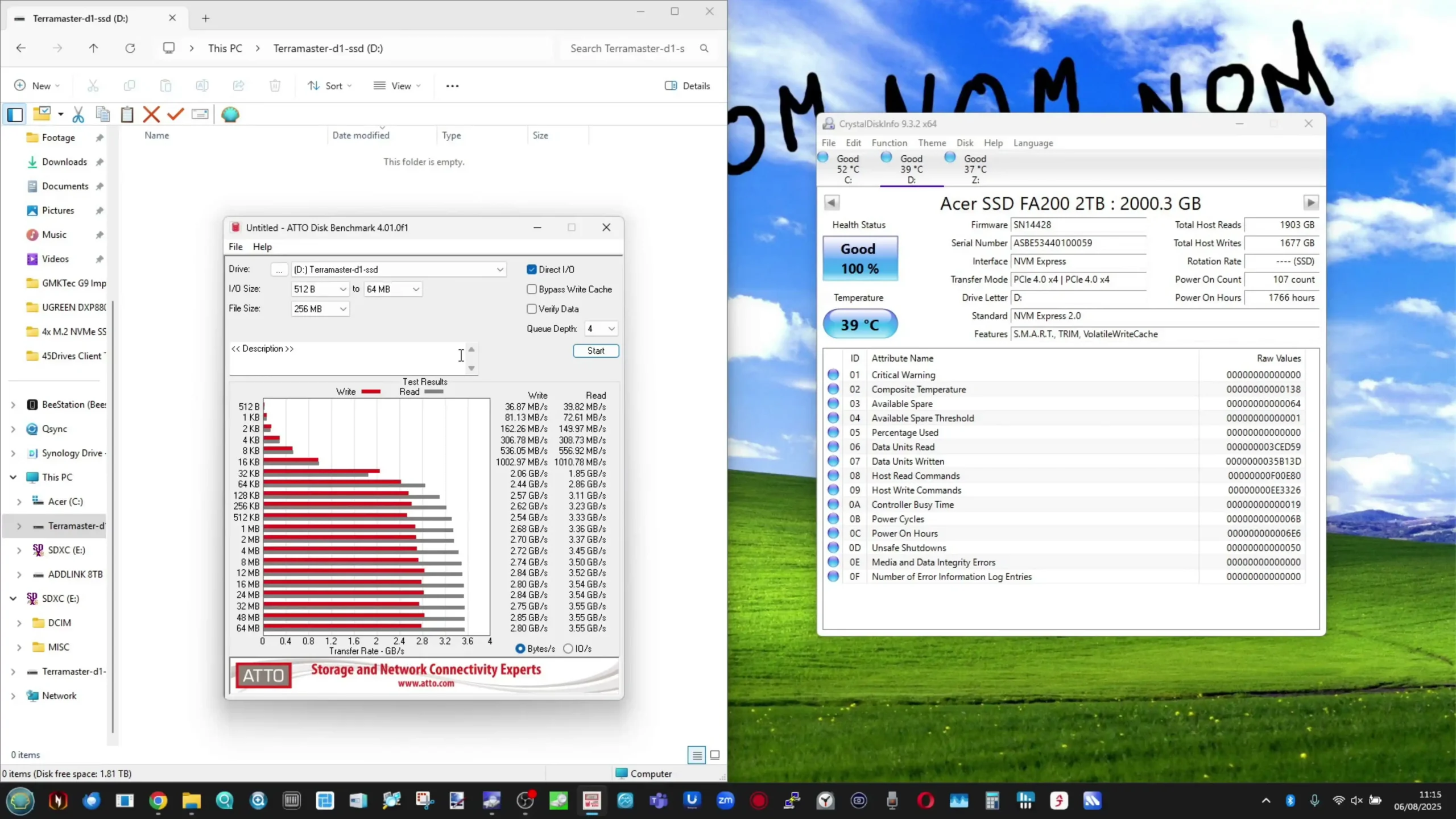
Real-world file transfers also reflected strong performance. A 100GB mixed-content dataset consisting of video clips, high-resolution images, PDFs, and documents transferred in 63 seconds, averaging 1.58GB/s over the duration. While this figure is lower than synthetic benchmark peaks, it remains well above the speeds of typical USB 3.2 enclosures, providing tangible time savings for users moving large batches of files. The ability to maintain high sustained write speeds is particularly beneficial for workflows such as direct-to-disk recording or continuous large dataset backups.
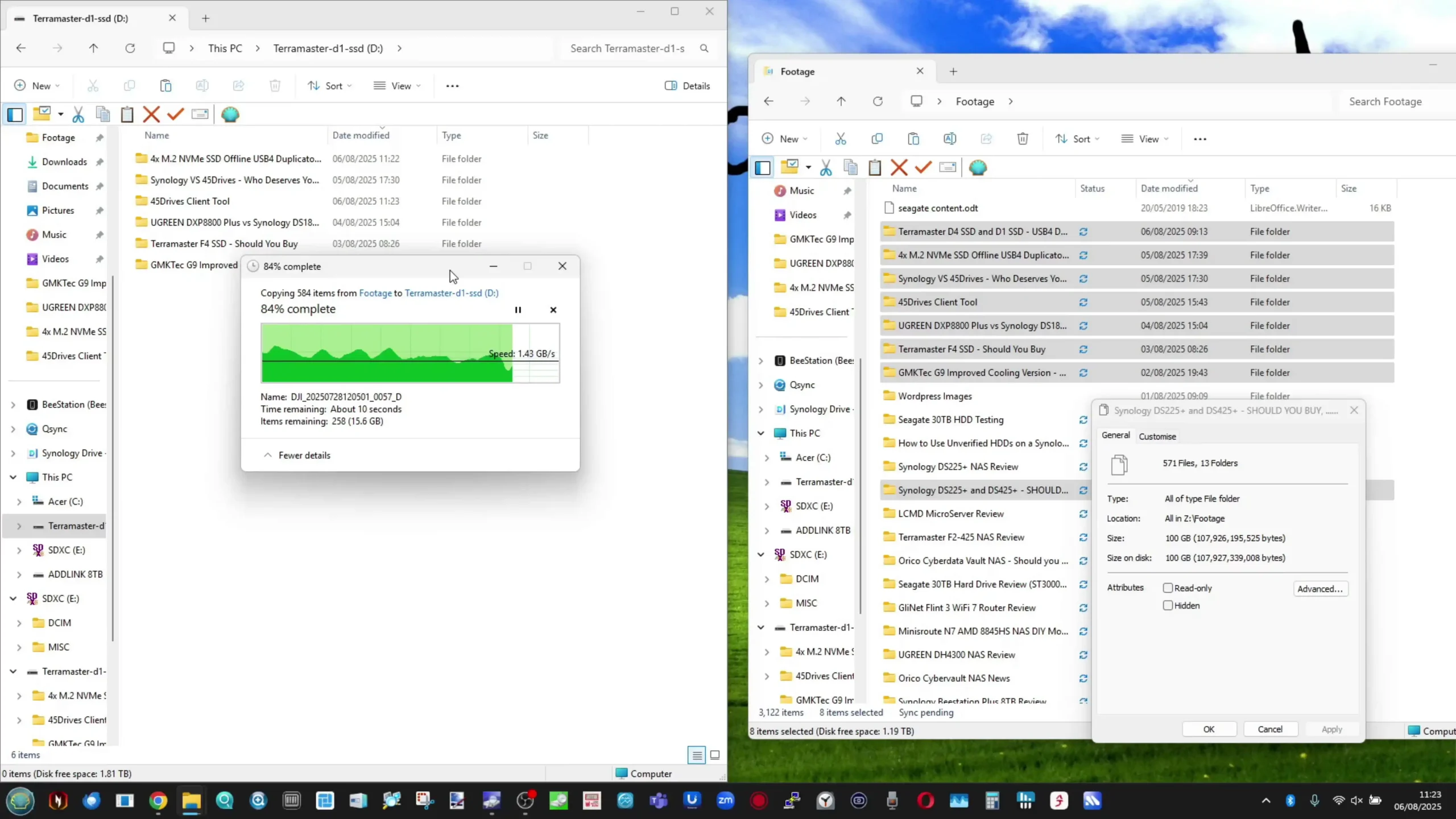
Temperature monitoring during performance testing showed the installed SSD peaking at 44–45°C after over five minutes of sustained large file writes, with the enclosure’s exterior registering around 41–42°C. These results suggest that the cooling system is sufficient to handle extended workloads without user intervention, making the D1 SSD Plus a viable option for scenarios where the drive may be used heavily for prolonged periods, such as editing directly from the external storage.
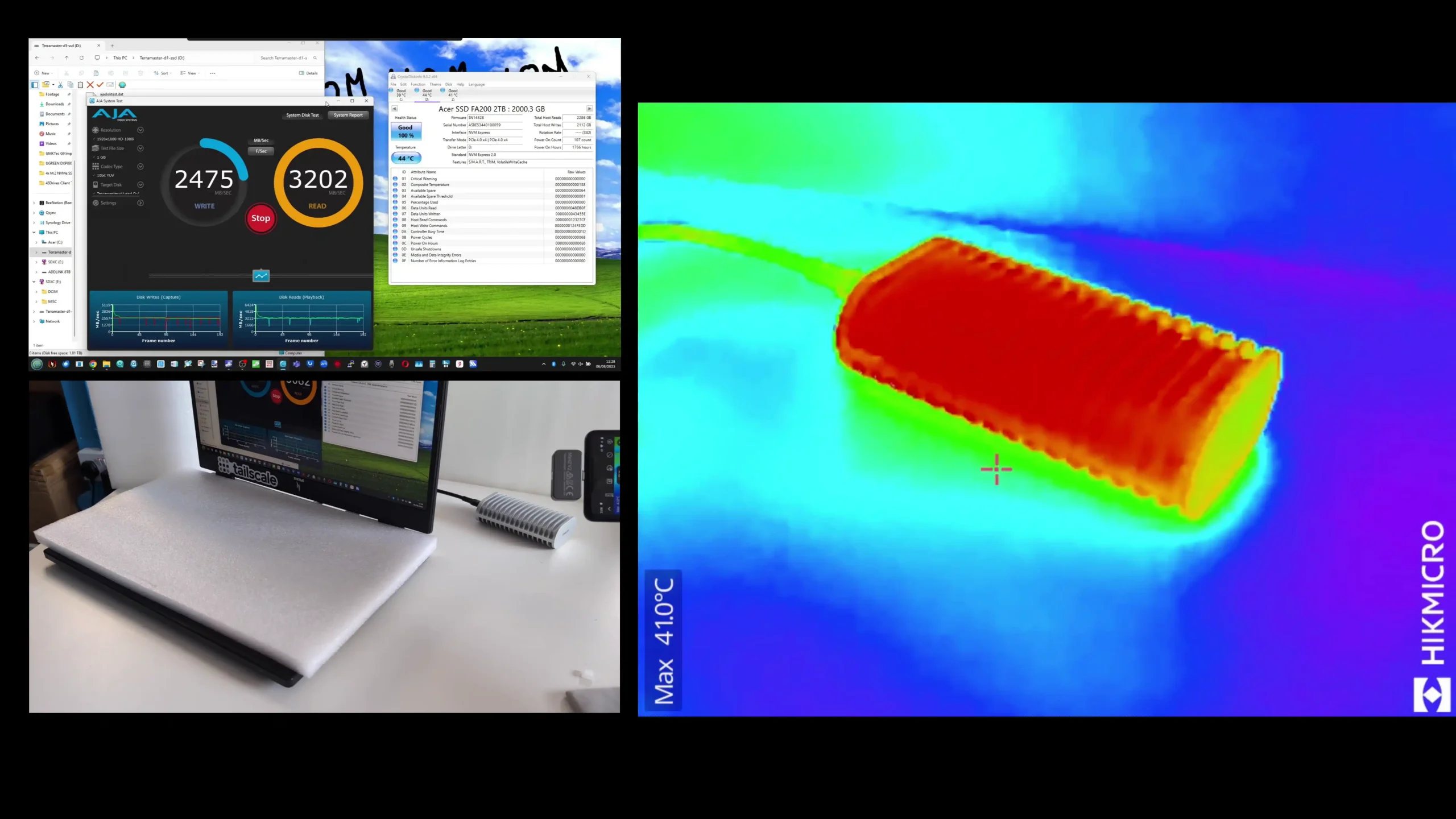
| Test Type | Read Speed (MB/s) | Write Speed (MB/s) | Notes |
|---|---|---|---|
| AJA 1GB loop | 3,000–3,100 | 2,550–2,600 | Sustained, no throttling |
| AJA peak | 3,550 | 2,800 | Short bursts |
| CrystalDiskMark sequential | ~3,089 | ~2,600 | Consistent across multiple runs |
| Mixed workload (70/30 R/W) | ~2,500 | ~2,500 | Balanced read/write workload |
| 100GB real-world transfer | Avg. 1,580 | N/A | Completed in 63 seconds |
| Peak SSD temperature | N/A | N/A | 44–45°C (enclosure 41–42°C) during sustained use |
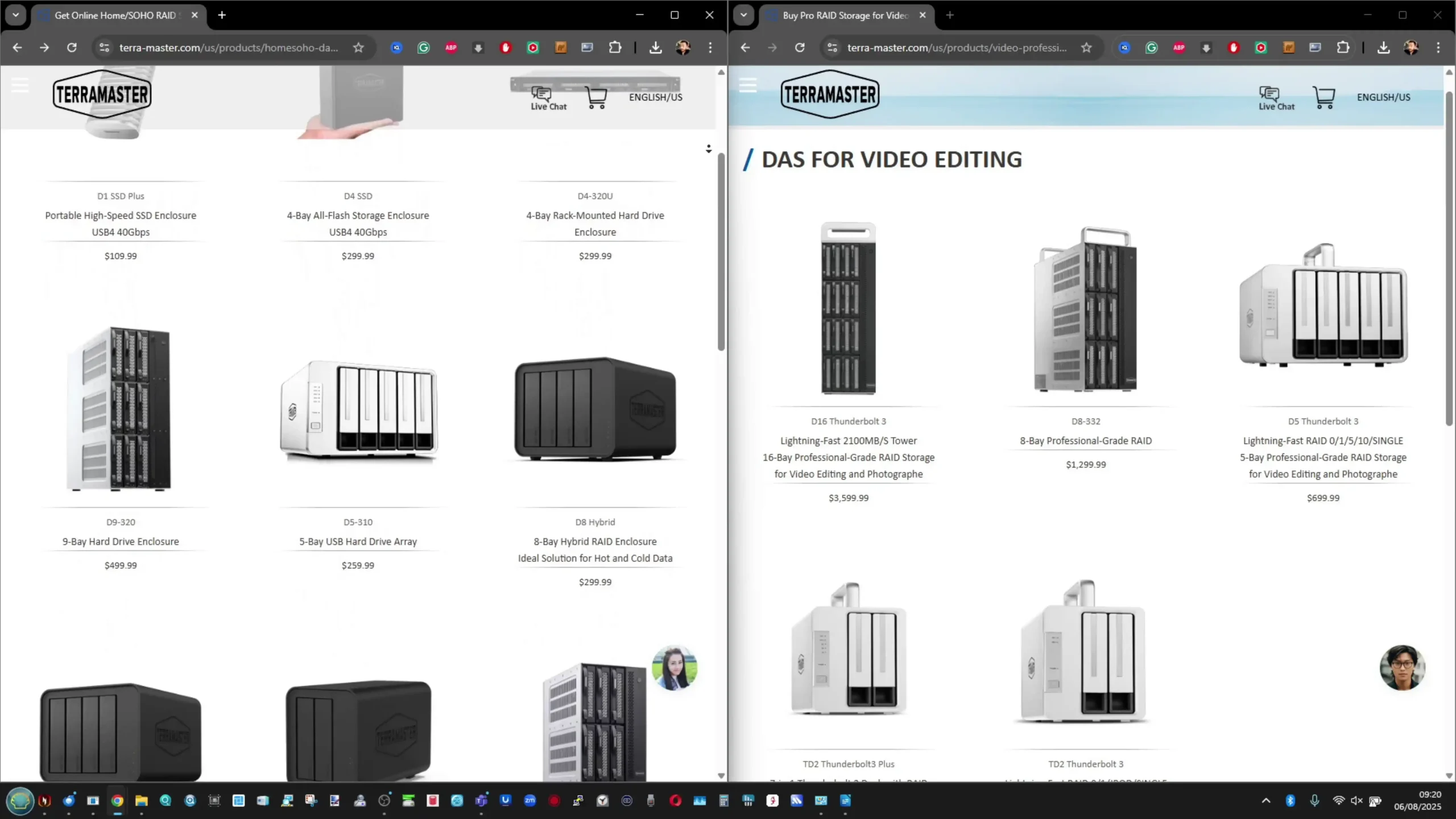
Terramaster D1 SSD Review – Verdict and Conclusion
The TerraMaster D1 SSD Plus positions itself as a high-speed, bus-powered USB4 enclosure that places equal emphasis on sustained performance, heat management, and compatibility across multiple connection standards. Its integration of the ASMedia ASM2464PDX controller with a PCIe Gen 4×4 lane configuration ensures that it can fully utilise the available 40Gbps bandwidth when paired with a suitable SSD, avoiding the thermal throttling that can undermine performance in less capable enclosures. TerraMaster’s decision to openly publish controller details, lane allocation, and maximum tested speeds gives technically minded buyers more confidence in what the enclosure can achieve, and helps explain why it maintained stability during repeated multi-gigabyte transfer tests in your review. The combination of a compact footprint, aluminium passive cooling, and complete silence during operation makes it suitable not only for static desktop setups but also for field work, where portability and reliability matter. With support for capacities up to 8TB and a choice of file systems including NTFS, exFAT, APFS, and EXT4, it can be easily integrated into both macOS and Windows workflows without major reconfiguration.
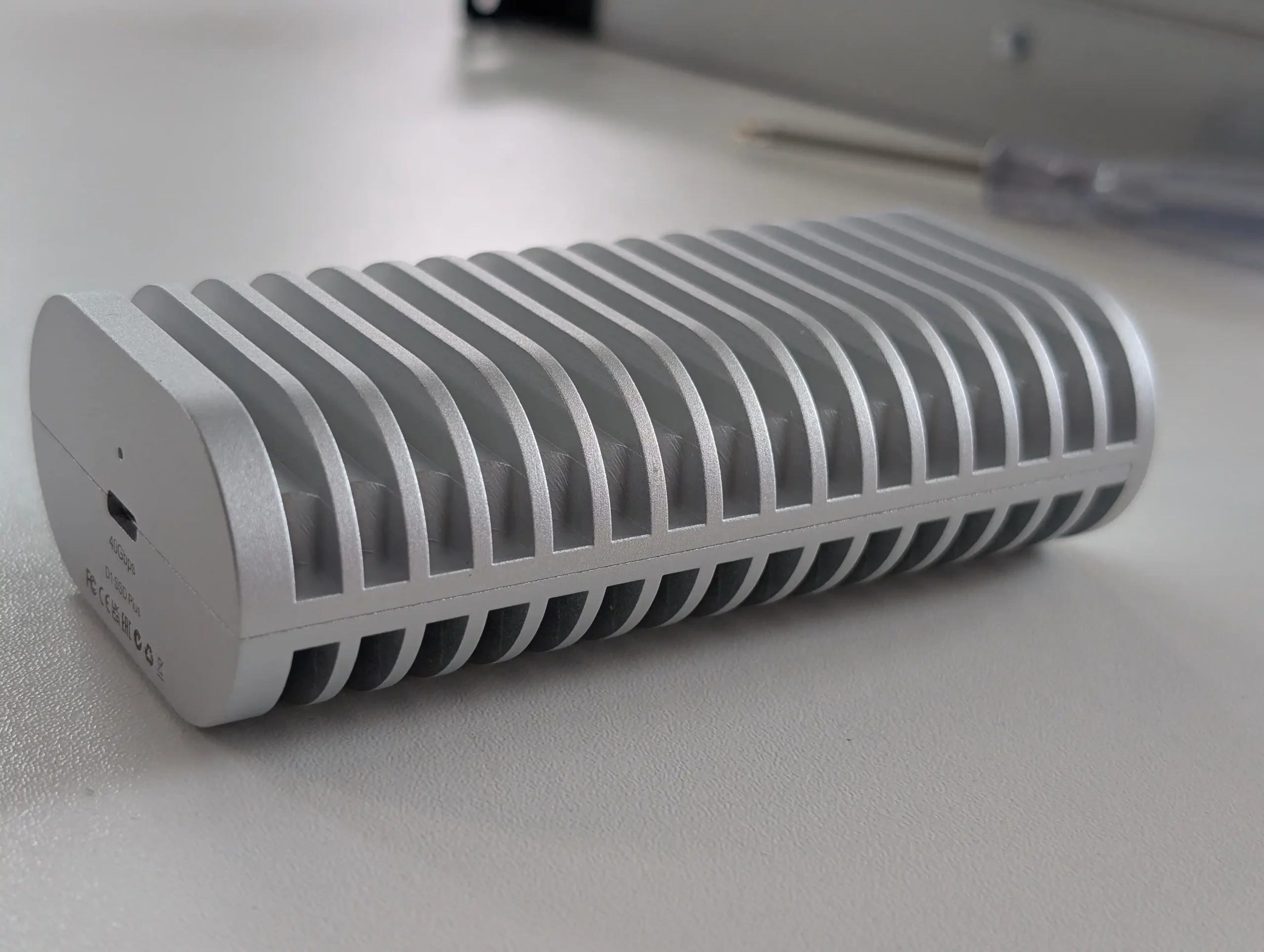
There are, however, practical considerations for prospective buyers. The included 0.3m USB4 cable, while capable of full 40Gbps data rates and 240W power delivery, is short enough to be inconvenient for tower PC users or multi-device workstations, and replacing it with a certified high-speed cable may be necessary in such environments. Furthermore, although the enclosure can accept any PCIe NVMe M.2 2280 SSD, achieving top-tier performance depends on selecting a PCIe Gen 4×4 drive, as using Gen 3 or slower-lane SSDs can halve the potential throughput. Your review also highlighted that while TerraMaster frequently notes the importance of Gen 4 drives, they do not provide detailed compatibility charts or recommend specific models, which could help less experienced buyers avoid suboptimal results. In practice, the D1 SSD Plus delivers a combination of sustained speed, thermal efficiency, and solid build quality that positions it as a strong choice for video editors, media professionals, and advanced home users who require portable storage without sacrificing reliability or performance.
|
Terramaster D1 SSD NAS |
|
|
Amazon in Your Region for the Terramaster D1 SSD @ $109 |
B&H for the Terramaster D1 SSD USB4 Drive @ $109.99 |
| PROs of the Terramaster D1 SSD | CONs of the Terramaster D1 SSD |
|
|
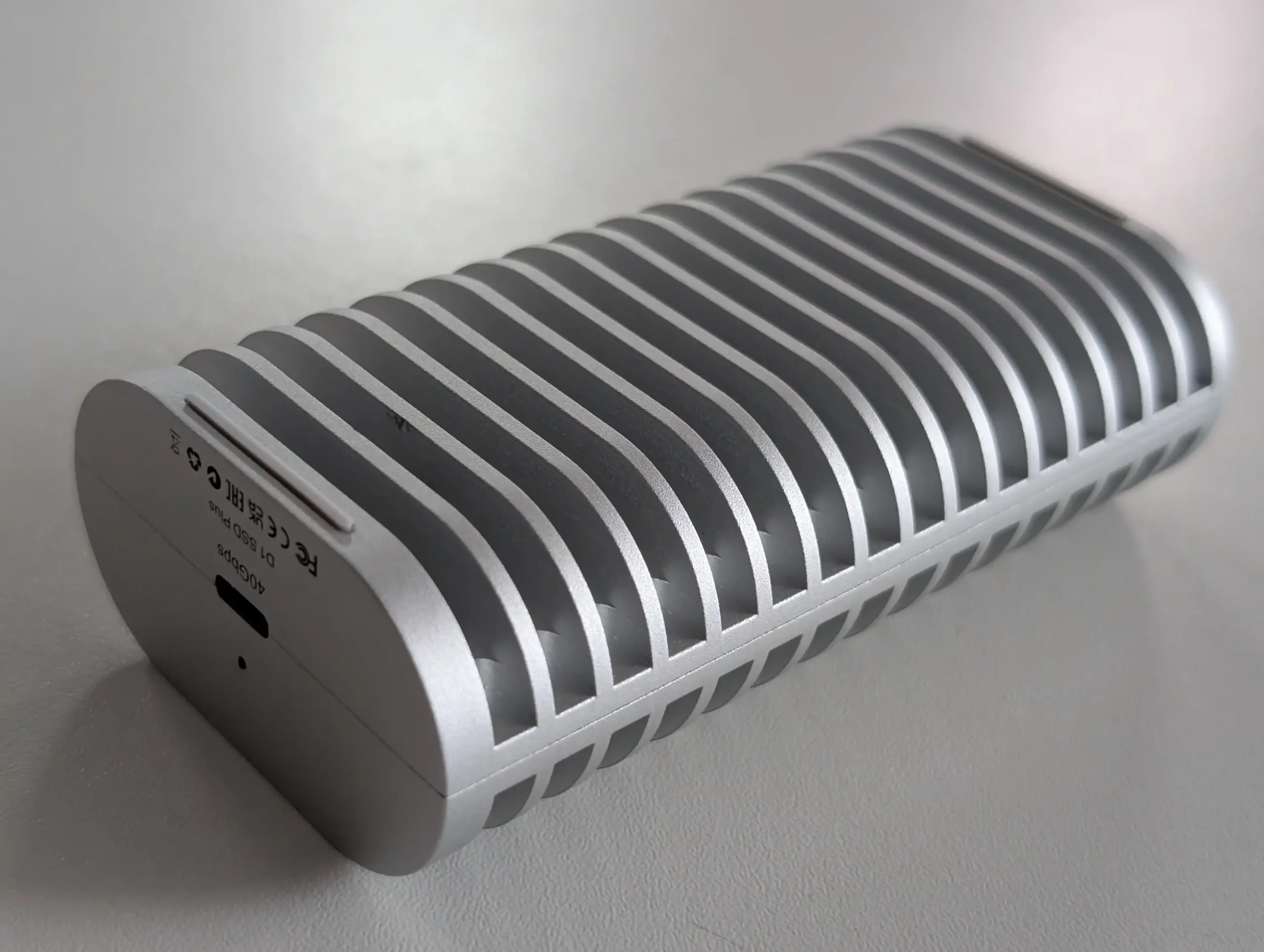
📧 SUBSCRIBE TO OUR NEWSLETTER 🔔
🔒 Join Inner Circle
Get an alert every time something gets added to this specific article!
This description contains links to Amazon. These links will take you to some of the products mentioned in today's content. As an Amazon Associate, I earn from qualifying purchases. Visit the NASCompares Deal Finder to find the best place to buy this device in your region, based on Service, Support and Reputation - Just Search for your NAS Drive in the Box Below
Need Advice on Data Storage from an Expert?
Finally, for free advice about your setup, just leave a message in the comments below here at NASCompares.com and we will get back to you. Need Help?
Where possible (and where appropriate) please provide as much information about your requirements, as then I can arrange the best answer and solution to your needs. Do not worry about your e-mail address being required, it will NOT be used in a mailing list and will NOT be used in any way other than to respond to your enquiry.
Need Help?
Where possible (and where appropriate) please provide as much information about your requirements, as then I can arrange the best answer and solution to your needs. Do not worry about your e-mail address being required, it will NOT be used in a mailing list and will NOT be used in any way other than to respond to your enquiry.

|
 |
The Best Bits (and Worst Bits) of NAS of 2025!
Minisforum MS-02 Ultra Review
Minisforum N5 NAS, 6 Months Later - Better, Worse, the Same?
Beelink ME Pro NAS Revealed
Best SOLID STORAGE NAS of 2025
Should You Worry About the NanoKVM Hidden Microphone?
Access content via Patreon or KO-FI
Discover more from NAS Compares
Subscribe to get the latest posts sent to your email.


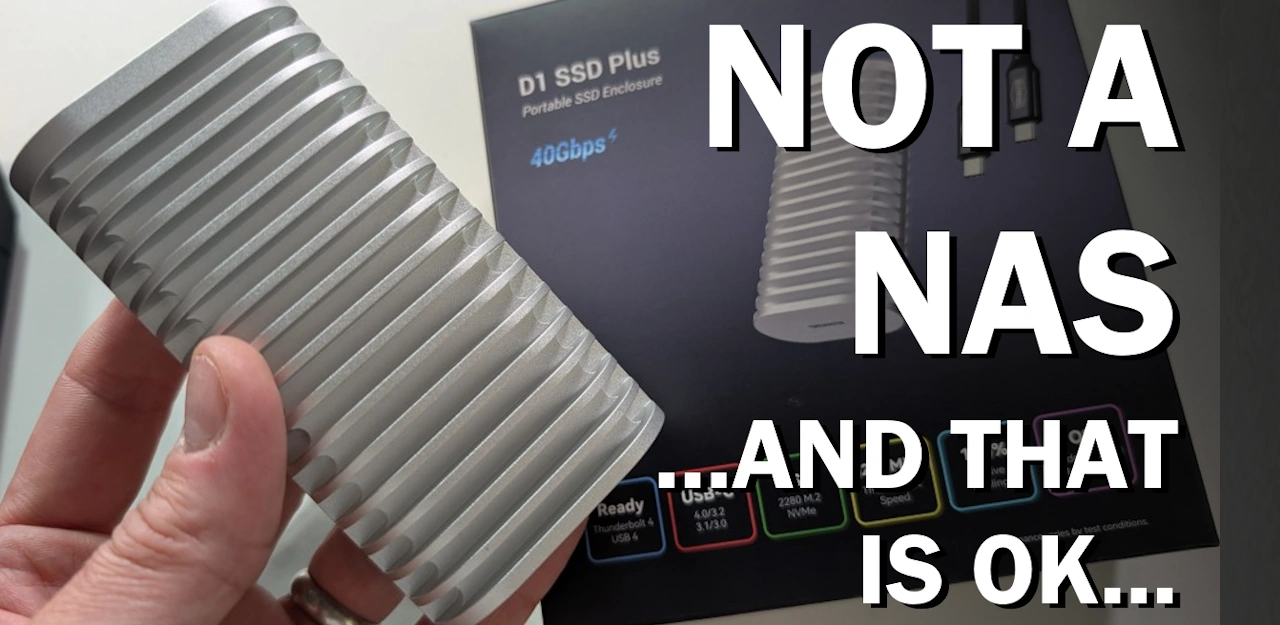





The “Corsair MP600 PRO NH” would be fully compatible with this enclosure?
REPLY ON YOUTUBE
Real power draw is higher than the official spec ~7 W idle, up to 15 W with a Samsung 990 Pro. Better than OWC Express 1M2, but still up to 4× a MacBook Air M, causing battery drain few reviewers mention. Sometimes it idles at 50 °C – a handy warmer. Still, in design and build, probably the best choice today if you need max speed.
REPLY ON YOUTUBE
The D1 SSD Plus looks exquisite and compact. It is a very good product. Thank you for your review.
REPLY ON YOUTUBE
Please do a review tear-down of the D4 320U
REPLY ON YOUTUBE
Sorry, maybe I missed it – which SSD would deliver best performance in the D1 ? I am looking at the Samsung 990 Pro, but you made a comment about DRAM that make me hesitate. Thx
REPLY ON YOUTUBE
I use the same concept full metal OWC 1M2 enclosures with fysic heat dissipation for high demanding high bitrate video editing storage since a year with good experiences with Mac Studio. It has a Thunderbolt 4 chip. The downside with the OWC interface is that it is getting very slow when using it backwards compatibility on non-TB4 usb-c 3 systems. I hope to find some information about this Terramaster D1 and how it backwards performs on usb-c. Thank you (as always).
REPLY ON YOUTUBE
Technically USB 40gbps would be better suited to nvme pcie3 x4 rather than pcie4 x2, it sucks wasting speed, but it is what it is
REPLY ON YOUTUBE
Virtually no manufacturer really specify the kind of drive to use in enclosures @nascompares
Terramaster seem to have gone further than many, if not most
There’s even reviewers whining about slow speed while they have either the wrong drive or the wrong connection on their host system to achieve those speeds …
REPLY ON YOUTUBE
Nice but too expensive for what it is.
REPLY ON YOUTUBE
In my view £100 is expensive for a case. Since watching this review- it’s pretty reasonable
REPLY ON YOUTUBE
I wish they would make this, but with two M.2 slots and RAID1. I want the data on my “external hard drives” to be reliable as well, and so it should be RAID1.
REPLY ON YOUTUBE
What about temps for double sided NVMes which most of the 4TB and 8TB are?
The one you tested it with was just single sided.
The heatsink type case seems to have contact with the NVMe just on one side. 4:24
PS: Love your channel and your videos. this is my first comment ever on youtube:). Just for you:).
REPLY ON YOUTUBE
ok that rack mounted solution is interesting. It opens the possibility with super small Servers without the need for special cards to attach SAN devices. you could easily expand your storage pool as long your system can provide USB. I mean, i have a NAS build with a iTX board. it is only a dual-core 7W cpu and i had to put it into a 3u case. Not because of the cooler but rater because of storage. THis tiny Bord has a cooler for a 1U space. it has 6 USB3 10gbit and 2 usb-C with DP and 20gbit 2 2.5gbit NICs, only 2 SATA ports, it uses SOIDMM DDR4 3600 and a x8 PCIE slot with bifurcation.
The problem was i didn’t got the right 90° riser in order to use my ASM1166 10 port HBA card, so it did not fit in my 1U chassis i bought. And i didn’t want to use USB enclosures, because they would be floating around in my rack. So i had to buy a bigger Chassis. i only use about 2U space of storage at the moment.
With that Terramaster Rack mount USB HDD enclosure i would be able puttung 4U worth of Storage in only 2U of space. 2 on the back and one plus the server on the front. The terramaster are 25cm in depth and my 1U Chassis i bought a while ago is only 50cm, its a Inter-Tech 1U chassis and my Rack has a post distance of 85cm. i guess this would be cool.
i mean my system now takes quite a bit of pace but it works too and i have still 7 to 10U left my in my rack on both sides.
REPLY ON YOUTUBE
So they need to expand it to more than one SSD then if it’s passive cooling is so effective. Did he ever review the Zike case? How does that compare in terms of temps?
REPLY ON YOUTUBE
Nas Compares is a sunday morning go to for my technology fix. Storage has come a long way.
REPLY ON YOUTUBE
If I attach a DAS to a NAS, does the DAS then technically become a NAS, or is it still a DAS?
REPLY ON YOUTUBE
The USB standard is nothing but.
REPLY ON YOUTUBE
I absolutely HATE the USB standard on PC. I have the best USB-C hub on the market.. I paid nearly $300 for 3 USB-c port hub.
Using BlackMagic Disk Speed Test A middle of the road USB 3.2 chip 11.1MB/s Write 146MB/s Read
My USB 3.2 NvMe enclosure 38.4MB/s Write and 40.9 MB/s Read
By way of Comparison My DS1522+ 10GB gets 616 MB/s write and 532MB/s read
REPLY ON YOUTUBE
not bad, I was expecting two m.2-s with a hw switch for raid 0 or 1…..anyhow, hope somebody makes that for U.2/U.3 drives, two 15TB external drives that can be accessed at speeds like if it were an internal drive while getting power and data ove usb4 would be impressive,
REPLY ON YOUTUBE
How does this compare to OWC 1M2 SSD enclosure?
REPLY ON YOUTUBE
Soooo.. what drives are recommended to go with this, according to you?
REPLY ON YOUTUBE
Good morning, and thank you for bringing us this Terramaster USB 4 enclosure update so early in the morning.
You give my morning tech life meaning. ????
I was a little excited when I saw the title come across. For me, it means these hard drive enclosure Knuckleheads are finally catching up with USB 4 DAS interface options.
Personally, I am waiting for a minimum of 6 Bay NVME drive solutions, other than ASUSTOR, with USB 4 DAS enclosure.
That would be awesome.
REPLY ON YOUTUBE